Charles Darwin
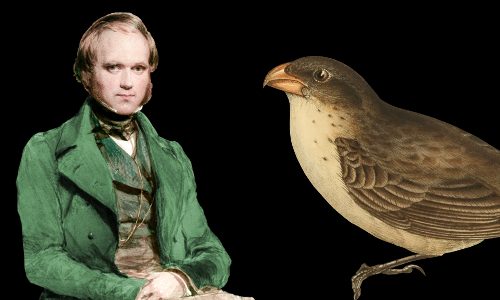
Lived 1809 – 1882.
Charles Darwin is often cited as the greatest biologist in history. His most famous work, On the Origin of Species, explains the theory of evolution by natural selection, providing numerous supporting examples. Darwin believed that all of life on earth had descended from a common ancestor, whose offspring could vary slightly from the previous generation. Successive generations of life took part in a struggle for existence in which the best adapted variations survived to seed new generations. Less well adapted variations became extinct.
Advertisements
Beginnings
Charles Robert Darwin was born into a wealthy family on February 12, 1809 in the town of Shrewsbury, England, UK. He was the fifth child of six.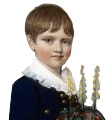
Charles Darwin, aged 7
His father, Robert Darwin, was a physician. Robert Darwin had grown rich by shrewdly investing money earned from his medical practice.
Charles’s mother was Susannah Wedgewood, from the famous pottery family. She died when Charles was eight years old. He then started attending an elementary school
School
At the age of nine, Charles was sent to Shrewsbury School, about a mile from his family home. He boarded there, often briefly returning home to keep up with family goings-on.
His boarding school followed a traditional classical curriculum revolving around Ancient Greek and Latin, which Charles loathed. He was not considered to be particularly smart. His foreign language skills were poor.
His schoolwork usually involved learning by heart for the next day lines of Roman or Greek literature. Although he disliked doing this, he was happy to work hard. He learned his lines thoroughly, then promptly forgot them all again as soon as class was over.
He enjoyed hunting and going for long walks, observing and collecting things from the natural world. At one point he became so obsessive about hunting that his father declared:
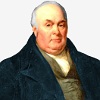 “You care for nothing but shooting, dogs, and rat-catching, and you will be a disgrace to yourself and all your family.”
“You care for nothing but shooting, dogs, and rat-catching, and you will be a disgrace to yourself and all your family.”
Robert Darwin
Charles Darwin’s Father
His brother built a chemistry laboratory in the garden tool-house, and Charles helped with experiments, often late into the night. Chemistry became his favorite subject. Unfortunately, it was not part of his school’s curriculum. In fact he was reprimanded his headmaster for ‘wasting his time’ on chemistry!
Edinburgh and Medical School
In 1825, aged 16, Charles became a medical student at the University of Edinburgh, as his father had done 42 years earlier. His father had pleasant memories of Edinburgh, where he was taught by the great chemist Joseph Black, who discovered magnesium, carbon dioxide, and latent heat.
Unlike his father, however, Charles did not enjoy medical school.
He found that dissecting human bodies disgusted him, being present during surgical operations horrified him, and visiting hospital wards distressed him. Moreover, attending lectures bored him:
 “The instruction at Edinburgh was altogether by lectures, and these were intolerably dull, with the exception of those on chemistry.”
“The instruction at Edinburgh was altogether by lectures, and these were intolerably dull, with the exception of those on chemistry.”
Charles Darwin
Autobiography, written 1876
In his second year at Edinburgh, Charles became interested in zoology, and he collected and dissected marine creatures. He also attended geology lectures, but found them incredibly boring.
His exasperated father decided to halt Charles’s medical studies. He withdrew his son from Edinburgh and sent him to the University of Cambridge with the idea that his idle son would eventually become a Church of England clergyman.
Cambridge and an Easy Degree
Early in 1828, just before his twentieth birthday, Charles Darwin enrolled at the University of Cambridge to study for a Bachelor of Arts degree.
After three easy years he received his B.A. degree with marks placing him near the top of the class. He had spent much of his time hunting, dining, drinking, and playing cards – all of which he enjoyed heartily.
Ironically, given Darwin’s later work, his favorite book at university was Evidences of the Existence and Attributes of the Deity. Its author, William Paley, used the example of a watch and a watchmaker in support of his argument that the natural world had been designed by God. Each species of life is much more complex than a watch, Paley said, therefore clearly these species must have been designed by someone – and that someone was God.
The Natural World
During his time in Cambridge, Darwin continued to pursue his scientific interests, particularly in botany and zoology: his greatest interest by far was in collecting different species of beetle.
 “One day, on tearing off some old bark, I saw two rare beetles, and seized one in each hand; then I saw a third and new kind, which I could not bear to lose, so that I popped the one which I held in my right hand into my mouth. Alas! it ejected some intensely acrid fluid, which burnt my tongue so that I was forced to spit the beetle out, which was lost, as was the third one.”
“One day, on tearing off some old bark, I saw two rare beetles, and seized one in each hand; then I saw a third and new kind, which I could not bear to lose, so that I popped the one which I held in my right hand into my mouth. Alas! it ejected some intensely acrid fluid, which burnt my tongue so that I was forced to spit the beetle out, which was lost, as was the third one.”
Charles Darwin
Autobiography, written 1876
After finishing at Cambridge, he began taking a serious interest in geology, studying rocks near his hometown of Shrewsbury and going on a two week expedition to Wales mapping rock strata.
Charles Darwin’s Contributions to Science
The Voyage of the Beagle 1831 – 1836
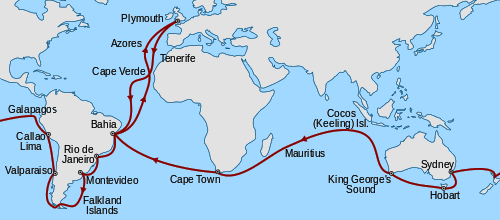
Darwin spent nearly five years traveling around the world on the Beagle.
The Beagle was scheduled to make a long expedition to the South Seas. Darwin would have to pay for his place on the ship, but would be at liberty to collect specimens and send them back to the United Kingdom for his own use or profit.
It was a wonderful opportunity to emulate his hero Alexander von Humboldt. Darwin was determined to grab it with both hands. His father, with some reluctance, agreed to pay for his son’s voyage.
The voyage, much like the fictitious Starship Enterprise’s, was a five year mission. It followed the route shown on the map above. The conditions on the small ship were much less comfortable than those enjoyed by the Starship Enterprise’s crew!
Plan of HMS Beagle
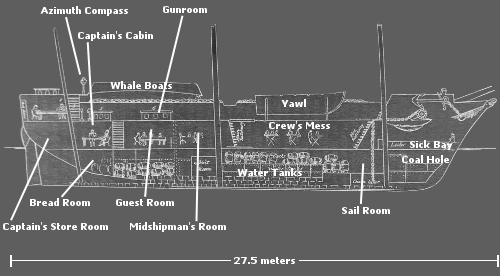
The Beagle – A cramped home for a five year voyage
While sailing southward from the British Isles, the Beagle’s first stop was at the volcanic Cape Verde Islands, west of Africa. Darwin found seashells high up in cliffs there. The Beagle’s captain, who had a great interest in the natural world, helped Darwin explain the observation, giving him a copy of Charles Lyell’s Principles of Geology.
Principles of Geology explained uniformitarian ideas in geology – the theory of gradualism, first proposed late in the previous century by James Hutton. A few years later the book’s author, Charles Lyell, would become one of Darwin’s greatest friends and supporters.
The expedition continued, with Darwin writing about his experiences in each new place he visited, collecting samples of flora, fauna, and fossils, and observing rock formations.
He saw a variety of unusual, unique species on the Galapagos Islands. Each separate island seemed to have its own distinct varieties of wildlife. Observations like these provoked him to write late in the voyage:
 “such facts would undermine the stability of Species.”
“such facts would undermine the stability of Species.”
Charles Darwin
1835
Darwin arrived back in England in October 1836. He had kept in touch with John Henslow, sending him notes regularly about his geological work on the expedition. Henslow put these notes together into a 31 page pamphlet, which he distributed to Cambridge’s scientific community and beyond.
Henslow also showed paleontologists fossils Darwin sent him, which caused more excitement.
Although Darwin embarked on the voyage as an unknown recent graduate, he returned as a respected, well-known scientist. Also, he assembled a large, exciting collection of specimens that naturalists were queuing up to study and catalog.
His father was relieved his prediction that Charles would disgrace the family had been proven wrong. Charles Darwin was now admired in the world of natural science, and his father agreed to continue funding his work. In fact, other people also recognized the value of Darwin’s work, and he now received a large grant from the British government to write up his observations from the Beagle’s expedition.
Scientific Results from Darwin’s Voyage
Darwin established that the South American continent is gradually rising from the ocean. Charles Lyell, whose geology book influenced Darwin on the voyage, arranged for Darwin to present this work to the Geological Society of London at the beginning of 1837.At the same meeting Darwin presented specimens of birds he had collected from the Galapagos Islands. Within a week, the ornithologist John Gould examined the specimens and declared the birds belonged to an entirely new group of finches. Darwin had discovered 12 new finch species and a new group of finches.
Evolution by Natural Selection
On his long voyage, at times mesmerized by nature’s abundance, Darwin’s thoughts had increasingly turned to the question of how different species had formed.Earlier Ideas about Evolution
The concept of evolution had been hatched thousands of years before Darwin’s time.His grandfather, Erasmus Darwin, had made some striking contributions to evolutionary theory, including the idea that all life has a common origin.
Darwin’s Theory
In July 1837 Darwin began keeping a notebook of his thoughts and theories about the variation of plants and animals.By this time, he had completely accepted that species could evolve (or, to use Darwin’s language, transmute).
He decided he would make his investigation according to the principles of Francis Bacon – he would assemble facts before producing a theory.
In October 1838 he read Thomas Malthus’s work on population, showing that populations increase until food runs out, then crash. There is a struggle for existence. Darwin said that having read Malthus:
 “It at once struck me that under these circumstances favorable variations would tend to be preserved, and unfavorable ones to be destroyed. The result of this would be the formation of new species. Here, then, I had at last got a theory by which to work.”
“It at once struck me that under these circumstances favorable variations would tend to be preserved, and unfavorable ones to be destroyed. The result of this would be the formation of new species. Here, then, I had at last got a theory by which to work.”
Charles Darwin
Autobiography, written 1876
In 1842 he wrote his first paper on what came to be known as evolution by natural selection, but only for his own use.
In 1845 he published thoughts, formed much earlier, about the new species of finches he discovered in the Galapagos Islands, saying he could imagine that one original species had been modified into all the different species.

Darwin decided that the different species of finches on the Galapagos Islands were all descended from a single finch ancestor.
- gathering and weighing evidence and assessing specimens from his voyage
- breeding animals and plants to determine how species could be modified by artificial selection
- writing books and papers about a variety of topics including geology
Darwin’s Hand is Forced
On 18 June 1858, aged 49, Darwin opened his mail and got a terrible shock. He had been corresponding with Alfred Russel Wallace, a young, self-trained naturalist who was on an expedition in the East Indies.Wallace now asked for Darwin’s opinion of a paper he had written. The paper described the theory of evolution by natural selection – the theory Darwin had spent decades gathering evidence for, but had never published. Darwin wrote back, offering his opinion that Wallace’s paper could be published in any journal of Wallace’s choosing.
Darwin also showed Wallace’s paper to his scientific friends Charles Lyell (Wallace had requested this) and Joseph Dalton Hooker.
Darwin was in crisis at this time because his young son had been terribly sick, eventually dying of scarlet fever on June 28.
His friends were aware that Darwin actually arrived at the theory first. They decided the joint theories of Darwin and Wallace should be read to the Linnean Society on July 1. Darwin did not attend the reading. His place was at his son’s funeral.
In the event, the reading of the Darwin-Wallace paper provoked little interest.
The Origin of Species
Darwin’s game-changing book On the Origin of Species – often called the most important book in the history of biology – became available to the public on November 24, 1859; booksellers immediately sold all 1250 copies.Trying to avoid controversy, Darwin avoided making any claims for the origin a particular species, such as Homo sapiens. He did however, in agreement with his grandfather’s much earlier theory, write:
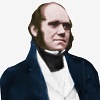 “… probably all the organic beings which have ever lived on this earth have descended from some one primordial form, into which life was first breathed.”
“… probably all the organic beings which have ever lived on this earth have descended from some one primordial form, into which life was first breathed.”
Charles Darwin
On the Origin of Species, 1859
Some of the most familiar ideas of ‘Darwinism’ did not appear until the later editions: the famous phrase “survival of the fittest” appeared for the first time in the 1869 fifth edition. Remarkably, the word evolution made its first appearance in the sixth edition in 1872.
In support of his theory of common ancestry, Darwin was particularly taken by the similarity of the embryos of different species.
 “Hardly any point gave me so much satisfaction when I was at work on the ‘Origin,’ as the explanation of the wide difference in many classes between the embryo and the adult animal, and of the close resemblance of the embryos within the same class.”
“Hardly any point gave me so much satisfaction when I was at work on the ‘Origin,’ as the explanation of the wide difference in many classes between the embryo and the adult animal, and of the close resemblance of the embryos within the same class.”
Charles Darwin
Autobiography, written 1876
Further Work
In 1868 Darwin wrote The Variation of Animals and Plants under Domestication. Feeling the need to offer a mechanism for heredity, and unaware that Gregor Mendel had already provided it, Darwin incorrectly proposed heredity resulted from a process called pangenesis.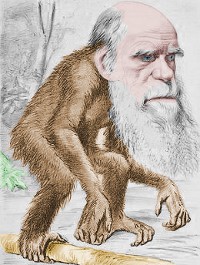
Many people believed that Darwin’s proposed descent of humans from apes was an attack on society’s moral foundations.
During Darwin’s lifetime, there was fierce opposition to his theory.
The great German pathologist Rudolf Virchow, for example, opposed Darwin from the beginning and never relented in his opposition.
In fact, in 1877, Virchow said the idea that man had descended from apes was an attack on society’s moral foundations. He voiced his opinion that teaching the theory of evolution should not be permitted in Germany’s public schools.
In 1872 Darwin looked at the evolution of human psychology in his book The Expression of the Emotions in Man and Animals, showing there are similarities in human and animal psychology.
The idea that species evolve had become accepted by most mainstream scientists by about the time the sixth edition of The Origin of Species came out in 1872.
The concept of natural selection, however, was less accepted. In considering the rate at which natural selection pushed evolutionary change, Darwin was heavily influenced by his friend Charles Lyell’s championing of gradualism.
 “Natural selection acts solely by accumulating slight successive favorable variations, it can produce no great or sudden modification; it can act only by very short steps.”
“Natural selection acts solely by accumulating slight successive favorable variations, it can produce no great or sudden modification; it can act only by very short steps.”
Charles Darwin
Origin of Species
Some Personal Details and the End
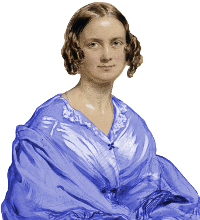
Darwin’s wife Emma two years after their marriage.
The couple had ten children; three died in childhood.
Three of their sons, George, Francis, and Horace, became notable scientists and were elected fellows of the Royal Society. George became an astronomer, Francis a botanist, and Horace an engineer.
Another son, Leonard, financially supported the publication of Ronald Fisher’s earliest work.
In 1837, as he began to work hard on a multi-volume book of observations from the Beagle expedition, and simultaneously began seriously researching the transmutation of species, Darwin fell ill. He would be plagued by ill-health for the rest of his life.
In 1842 he moved with his family to a country house outside London, away from the smoke and dirt. He lived a quiet life, not socializing much, concentrating on family life and writing books and scientific papers.
In 1864 Darwin was awarded the Copley Medal, then the greatest honor in science. The award was for:
“his important researches in geology, zoology, and botanical physiology.”Previous winners included Benjamin Franklin, Alessandro Volta, Hans Christian Oersted, Michael Faraday, Alexander von Humboldt, Charles Lyell, and Robert Bunsen.
Charles Darwin died aged 73 on April 19, 1882, of heart failure at his country house. He was buried in Westminster Abbey, London, next to John Herschel whose work had inspired him at university, and near his best friend Charles Lyell, whose work had influenced him greatly. Other scientists buried in Darwin’s vicinity at Westminster Abbey include Isaac Newton, Ernest Rutherford, J. J. Thomson, and Lord Kelvin.
Advertisements
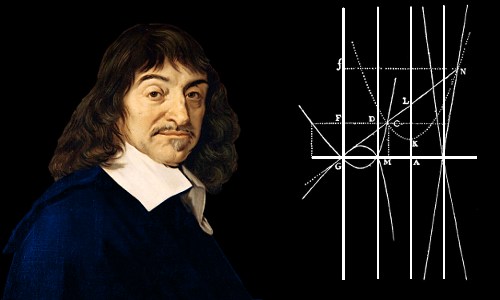
No comments:
Post a Comment